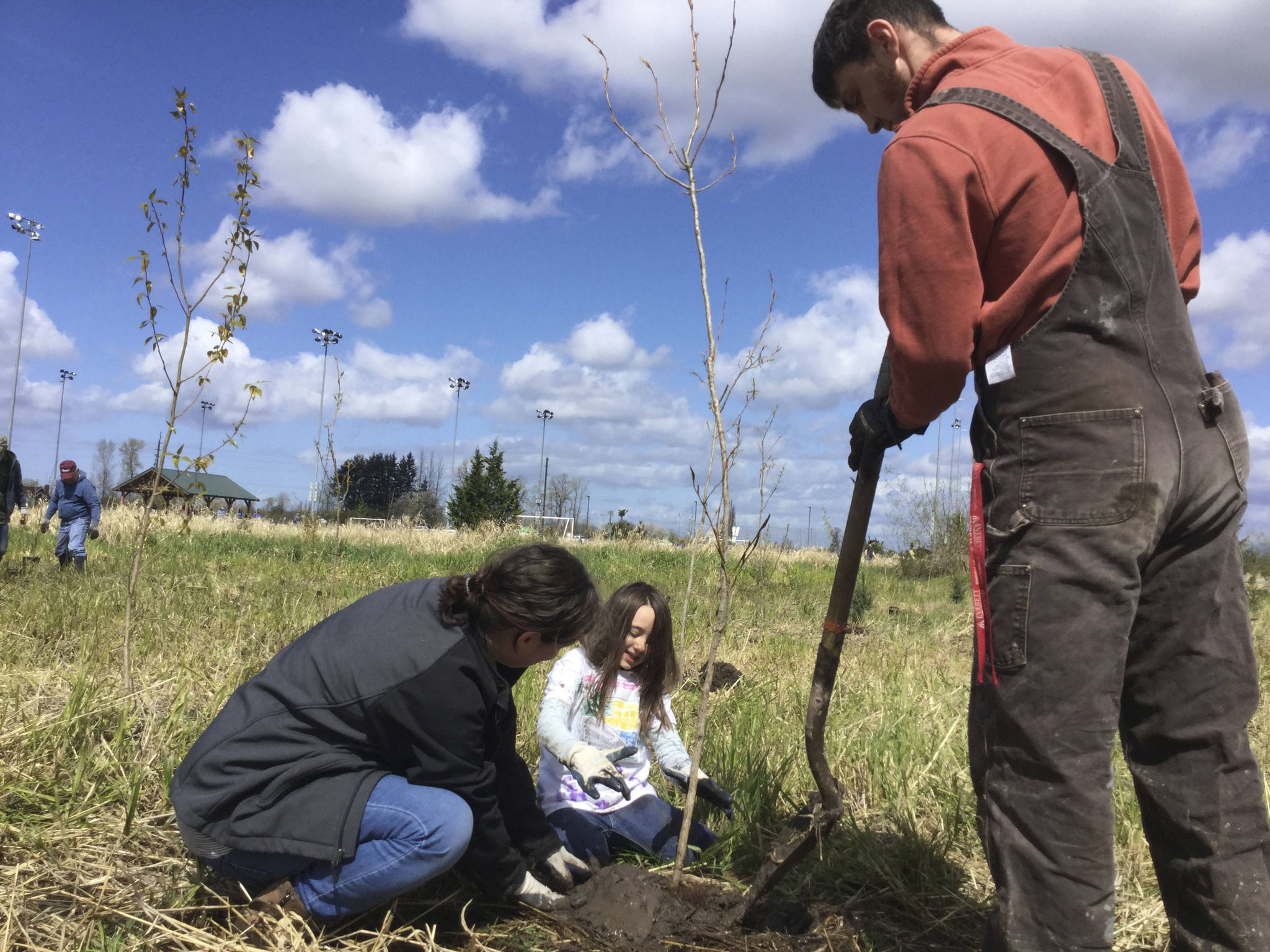MARYSVILLE – Justine Brock and her parents trudged through mud and reed canary grass with dozens of Earth Day volunteers Saturday to plant trees in a field that was under a foot of water three days earlier.
“Justine is really passionate about trees and planting them,” her mother Alexa said as they admired their work at Strawberry Fields Park.
So much so, the Lakewood Elementary School student doesn’t want to stop at Marysville and Arlington – she wants to lead a fundraising drive for her school to donate trees for the National Park Service.
“It’s just my heart,” said Justine, 7, who was dressed in an Earth Day t-shirt she designed herself.
That love of nature is music to the ears of ecologists like Zac Mallon with the Adopt-A-Stream Foundation, who teamed up with the cities of Arlington and Marysville for the event that planted more than 1,600 trees along the middle fork of Quilceda Creek.
“It’s really important to engage with people when they’re young because that helps them to establish an environmental ethic,” Mallon said. “These kids, if they are able to stay in the area, are going to be able to come back here ten years from now, see these trees and say, ‘I did that.’”
The Brocks were one of several families and individuals who helped plant potted trees to create a riparian buffer to improve water quality in the creek.
The landscape was dotted with trees, ranging from Black cottonwood, Douglas firs and cedars to beech hazelnet and spruce, along with hearty shrubs including twinberry, salmon berry and Pacific nine bark, foliage that will create excellent ground cover, Mallon said.
Kyle Stevenson, 11, said he was exhausted from what he figures was a few dozen trees he and his Marysville family planted. Water and mud got into his waders, but he was proud of the work they did.
“I like to volunteer because it’s fun doing something that helps people and fish,” said Kyle, whose dad did most of the ground prep while he filled in and sculpted the mud and dirt around the trees. “It wasn’t hard getting most of the trees in the ground.”
Mallon said the event gives attendees an opportunity to learn more about salmon habitat and restoration efforts. Streams, wetlands and riparian corridors provide habitat for migratory fish and wildlife in and along the creek system. Projects such as the tree planting ultimately benefit both cities, the Tulalip Tribes and the region in coordinated surface water management efforts.
The middle fork of Quilceda Creek is on the state Department of Ecology’s 303(d) list for impaired waterbodies exceeding state water quality standards for temperature, dissolved oxygen and fecal coliform levels, Mallon said. Sediment from urban development, stormwater runoff, pesticide use, and livestock and pet waste all impact water quality.
“The solution is to plant trees,” Mallon said. Trees provide shade to the creek, which cools the water. In addition, the roots in the trees catch some of the nutrient runoff – and fecal coliform – coming from farms and neighborhoods, trapping it in the soil and keeping it out of the creek.
Reed canary grass is a tough invasive species to get rid of, but its days are numbered once growing condition around it change. “A reason we’re planting coniferous trees is that when they grow they will form a dense canopy, they will actually shade out the reed canary grass. Once you get a large canopy over the top of it, it can’t compete any longer,” Mallon said.
It may seem hard to believe that baby salmon are taking a breather this far upstream, but they’re there if you look closely. Many participants saw it with their own eyes. Adopt-A-Stream ecologist Walter Rung set an underwater camera in the creek that fed live video to a laptop. Coho salmon fingerlings could be seen swimming. Other fun activities included decorating free t-shirts, sipping hot chocolate, educational displays and playing the Salmon Lifecycle Game.



